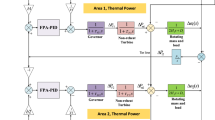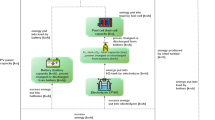Abstract
Demand side management (DSM) program is a key feature of smart grid and extensively used for its reliable functionalities and benefits of customers on electricity bill reduction. A DSM approach based on load shifting for a typical day is considered in this paper for a hierarchical smart grid structure. Renewable energy source such as wind energy is considered here along with conventional power generators. All the participants of electricity market: utility operator, customers and aggregator, wish to get monitory benefits in electricity market. It is quite challenging to ensure benefits to each participant simultaneously. To address the challenge, a multi-objective problem is framed. Further, using weighted sum technique, the multi-objective problem is transformed to a single objective. In this paper, a hybrid genetic algorithm (GA)–particle swarm optimization (PSO) (hybrid GA–PSO) algorithm is proposed to solve the problem developed. The objective of the proposed algorithm is to minimize cost of electricity bill and optimally allocate generation and load demand of a day-ahead market. The proposed hybrid algorithm is used to combine the strength of both GA and PSO algorithms and to help improve its performance by increasing the convergence speed and avoid trapping into local minima. In order to balance between exploration and exploitation a decision parameter: fusion factor, is introduced in this algorithm. The simulation results prove that the current approach is able to give financial advantage to all the participants of the electricity market simultaneously while optimally allocating load and generation profile for a day. It also helps to reduce peak to average ratio (PAR) of load demand and improves the efficiency and economy of smart grid. The results have also been compared with a few existing optimization techniques to show effectiveness of the current optimization algorithm.









Similar content being viewed by others
Abbreviations
- \(g_{c}\) :
-
Power generated from conventional generators
- \(g_{res}\) :
-
Power generated from renewable energy sources
- \(l_{a}\) :
-
Actual load demand
- \(l_{f}\) :
-
Forecasted load demand
- \(g_{t}\) :
-
Scheduled conventional power generation
- \({{F}_{UTILITY}}()\) :
-
Objective of utility operator
- \({{F}_{AGGRE}}()\) :
-
Objective of aggregator
- \({{F}_{CUSTOMER}}()\) :
-
Objective of customers
- \({f_{0}}()\) :
-
Cost of conventional generators without DSM
- \({f_{1}}()\) :
-
Cost of conventional generators with DSM
- \(\alpha \) :
-
Bonus coefficient
- \({\beta _{1}, \beta _{2}}\) :
-
Compensation coefficients
- \(\gamma \) :
-
In-elasticity coefficient
- \({\lambda }\) :
-
Scalar weight
- \(\tau \) :
-
Current iteration
- \({\xi }\) :
-
Inertia weight factor
- \(\zeta \) :
-
Fusion factor
- \(c_{a1}\), \(c_{a2}\) :
-
Acceleration constants
- P :
-
Number of particles
- \(r_{c}\) :
-
Crossover rate
- \(r_{m}\) :
-
Mutation rate
- \({{C}_{w}}\) :
-
Performance coefficient
- \(\eta \) :
-
Blade tip speed ratio
- \(\phi \) :
-
Blade pitch angle
- \(\rho \) :
-
Air density
References
Li F, Qiao W, Sun H, Wan H, Wang J, Xia Y, Xu Z and Zhang P 2010 Smart transmission grid: vision and framework. IEEE Transactions on Smart Grid 1(2): 168–177
Gungor V C, Sahin D, Kocak T, Ergut S, Buccella C, Cecati C and Hancke G P 2011 Smart grid technologies: communication technologies and standards. IEEE Transactions on Industrial Informatics 7(4): 529–539
Moslehi K and Kumar R 2010 A reliability perspective of the smart grid. IEEE Transactions on Smart Grid 1(1): 57–64
Janocha S, Baum S and Stadler I 2016 Cost minimization by optimization of electricity generation and demand side management. In: Proceedings of the 2016 International Energy and Sustainability Conference (IESC), IEEE, pp. 1–7
Gellings C W 1985 The concept of demand-side management for electric utilities. Proceedings of the IEEE 73(10): 1468–1470
Sepulveda A, Paull L, Morsi W G, Li H, Diduch C and Chang L 2010 A novel demand side management program using water heaters and particle swarm optimization. In: Proceedings of the 2010 IEEE Electrical Power and Energy Conference, IEEE, pp. 1–5
Balijepalli V M, Pradhan V, Khaparde S and Shereef R 2011 Review of demand response under smart grid paradigm. In: Proceedings of ISGT2011-India, IEEE, pp. 236–243
Schisler K, Sick T and Brief K 2008 The role of demand response in ancillary services markets. In: Proceedings of the 2008 IEEE/PES Transmission and Distribution Conference and Exposition, IEEE, pp. 1–3
Ma O, Alkadi N, Cappers P, Denholm P, Dudley J, Goli S, Hummon M, Kiliccote S, MacDonald J, Matson N, et al 2013 Demand response for ancillary services. IEEE Transactions on Smart Grid 4(4): 1988–1995
Yang D and Chen Y 2009 Demand response and market performance in power economics. In: Proceedings of the 2009 IEEE Power and Energy Society General Meeting, IEEE, pp. 1–6
Fahrioglu M and Alvarado F L 2000 Designing incentive compatible contracts for effective demand management. IEEE Transactions on Power Systems 15(4): 1255–1260
Aalami H, Yousefi G and Moghadam M P 2008 Demand response model considering EDRP and TOU programs. In: Proceedings of the 2008 IEEE/PES Transmission and Distribution Conference and Exposition, IEEE, pp. 1–6
Kim D M and Kim J O 2012 Design of emergency demand response program using analytic hierarchy process. IEEE Transactions on Smart Grid 3(2): 635–644
Gkatzikis L, Koutsopoulos I and Salonidis T 2013 The role of aggregators in smart grid demand response markets. IEEE Journal on Selected Areas in Communications 31(7): 1247–1257
Dethlefs T, Preisler T and Renz W 2015 Ant-colony based self-optimization for demand-side-management. In: Proceedings of SmartER Europe, Essen
Silva B N and Han K 2019 Mutation operator integrated ant colony optimization based domestic appliance scheduling for lucrative demand side management. Future Generation Computer Systems 100: 557–568
Logenthiran T, Srinivasan D and Shun T Z 2012 Demand side management in smart grid using heuristic optimization. IEEE Transactions on Smart Grid 3(3): 1244–1252
Goldberg D 2014 Genetic algorithms in search, optimization, and machine learning. Reading, MA: Addison-Wesley
Bharathi C, Rekha D and Vijayakumar V 2017 Genetic algorithm based demand side management for smart grid. Wireless Personal Communications 93(2): 481–502
Khan M A, Javaid N, Mahmood A, Khan Z A and Alrajeh N 2015 A generic demand-side management model for smart grid. International Journal of Energy Research 39(7): 954–964
Kennedy J and Eberhart R 1995 Particle swarm optimization (PSO). In: Proceedings of the IEEE International Conference on Neural Networks, Perth, Australia, pp. 1942–1948
Faria P, Vale Z, Soares J and Ferreira J 2011 Demand response management in power systems using particle swarm optimization. IEEE Intelligent Systems 28(4): 43–51
Gupta I, Anandini G and Gupta M 2016 An hour wise device scheduling approach for demand side management in smart grid using particle swarm optimization. In: Proceedings of the 2016 National Power Systems Conference (NPSC), IEEE, pp. 1–6
Cheng P H, Huang T H, Chien Y W, Wu C L, Tai C S and Fu L C 2020 Demand-side management in residential community realizing sharing economy with bidirectional PEV while additionally considering commercial area. International Journal of Electrical Power & Energy Systems 116: 105512
Li D, Chiu W Y, Sun H and Poor H V 2018 Multiobjective optimization for demand side management program in smart grid. IEEE Transactions on Industrial Informatics 14(4): 1482–1490
Purshouse R C and Fleming P J 2007 On the evolutionary optimization of many conflicting objectives. IEEE Transactions on Evolutionary Computation 11(6): 770–784
Wang R, Zhou Z, Ishibuchi H, Liao T and Zhang T 2016 Localized weighted sum method for many-objective optimization. IEEE Transactions on Evolutionary Computation 22(1): 3–18
Konak A, Coit D W and Smith A E 2006 Multi-objective optimization using genetic algorithms: a tutorial. Reliability Engineering & System Safety 91(9): 992–1007
Shamim G and Rihan M 2020 Multi-domain feature extraction for improved clustering of smart meter data. Technology and Economics of Smart Grids and Sustainable Energy 5: 1–8
Lokeshgupta B and Sivasubramani S 2018 Multi-objective dynamic economic and emission dispatch with demand side management. International Journal of Electrical Power & Energy Systems 97: 334–343
Hawe G I and Sykulski J K 2008 A scalarizing one-stage algorithm for efficient multi-objective optimization. IEEE Transactions on Magnetics 44(6): 1094–1097
Marler R T and Arora J S 2010 The weighted sum method for multi-objective optimization: new insights. Structural and Multidisciplinary Optimization 41(6): 853–862
Park J B, Jeong Y W, Shin J R and Lee K Y 2009 An improved particle swarm optimization for nonconvex economic dispatch problems. IEEE Transactions on Power Systems 25(1): 156–166
Logenthiran T, Srinivasan D and Phyu E 2015 Particle swarm optimization for demand side management in smart grid. In: Proceedings of the 2015 IEEE Innovative Smart Grid Technologies-Asia (ISGT ASIA), IEEE, pp. 1–6
Shi Y, et al 2001 Particle swarm optimization: developments, applications and resources. In: Proceedings of the 2001 Congress on Evolutionary Computation, IEEE Cat. No. 01TH8546, IEEE, vol. 1, pp. 81–86
Wang X, Gong Y and Jiang C 2014 Regional carbon emission management based on probabilistic power flow with correlated stochastic variables. IEEE Transactions on Power Systems 30(2): 1094–1103
Rahman S and Pipattanasomporn M 2010 Modeling and Simulation of a Distributed Generation-integrated Intelligent Microgrid, SERDP Project SI-1650
Zhang Q, Zou D, Duan N and Shen X 2019 An adaptive differential evolutionary algorithm incorporating multiple mutation strategies for the economic load dispatch problem. Applied Soft Computing 78: 641–669
Roy C, Das D K and Srivastava A 2019 Particle swarm optimization based cost optimization for demand side management in smart grid. In: Proceedings of the 2019 International Conference on Electrical, Electronics and Computer Engineering (UPCON), IEEE, pp. 1–6
Author information
Authors and Affiliations
Corresponding author
Rights and permissions
About this article
Cite this article
Roy, C., Das, D.K. A hybrid genetic algorithm (GA)–particle swarm optimization (PSO) algorithm for demand side management in smart grid considering wind power for cost optimization. Sādhanā 46, 101 (2021). https://doi.org/10.1007/s12046-021-01626-z
Received:
Revised:
Accepted:
Published:
DOI: https://doi.org/10.1007/s12046-021-01626-z




